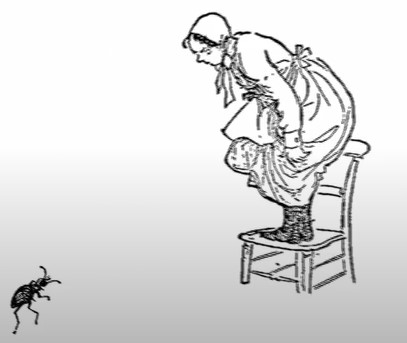Belcarra Garden Club
BC, Canada

Ground Beetles and Others
By Nora Boekhout and Les Bramley
 |
“I found a little beetle; so that Beetle was his name, And I called him Alexander and he answered just the same. I put him in a match-box, and I kept him all the day ... And Nanny let my beetle out - Yes, Nanny let my beetle out - She went and let my beetle out - And Beetle ran away.” from the poem “Forgiven” by A.A. Milne https://allpoetry.com/poem/8518989-Forgiven-by-A.A.-Milne |
 |
 |
Les got interested in a favourite topic of mine… BEETLES and BUGS! I’m sure that the Granulated Ground Beetle (Carabus granulatus) was the inspiration for A.A. Milne’s “Alexander Beetle”! Apparently, there are 40,000 species of ground beetles in the world and we have around 2,000 species in North America.
This little guy is another of our garden friends. This diverse group of predators is among the top 10 beneficial garden insects. Carabids eat other invertebrates such as insects, worms, snails, slugs, caterpillars, and cutworms! This is one of the few species of ground beetle that have not completely lost their ability to fly. They are nocturnal animals, generally remaining on the ground and hiding under rocks and wood debris by day. These beetles have been introduced from Europe and have spread across North America, living in fields, prairies, forests, gardens… "most everywhere”, we guess!
The Carabus is small (length between 14 and 20 mm). The antennae and legs are black; the upper part of the animal is shiny and predominantly black with metallic colors of greenish bronze or green. The elytra (hardened upper wings) are often grooved. The females lay about forty eggs near the soil surface. They undergo complete metamorphosis (egg, larva, pupa, and adult) which usually takes a full year. The larvae molt three times before pupating in the ground. Some species breed in the spring and overwinter as adults, gathered in tree stumps. Others breed in the summer and overwinter as larvae. Many ground beetles will produce pungent odors if handled or threatened.
Between the different species, they eat more than fifty types of pests, plus some even eat the seeds of weeds! Farmers have found a 30% decrease of weeds in their fields due to ground beetles. (So that can't be bad!) So appreciate those little ground beetles in your garden! Nature’s ways are better than pesticides!
On the subject of “good and bad” mini visitors in your garden, here is some information from “The Good, the Bad, and the Bugly (or How to Hire an Assassin)”.
Bad: Ants (can be good too!), Aphids, Apple Worms, Bean Beetles, Borers or Termites, Cabbage Math/Butterfly, Cane Toads, Carrot Flies, Click Beetles and Wire Worms, Cockroaches, Codling Moth and Fruit Fly, Cucumber Beetles, Cut Worms, Earwigs, Grasshoppers, Harlequin Bugs, Hornworm Caterpillars, Ladybugs with 26 and 28 spots only, Lawn Grubs, Leaf Miners, Mealy Bugs, Mosquitoes, Nematodes, Slaters, Slugs and Snails.
Good “Bennies” are the Beneficial visitors: Ants (can be bad too!), Assassin Bugs, Bats, Bees, Beetles, Birds, Butterflies, Centipedes, Dobson Fly, Dragonflies and Damselflies, Frogs, Hoverflies, Lacewings, Ladybugs (not the 6 or 28 spot varieties), Lizards, Praying Mantises, Robber Flies, Snakes, Spiders, Wasps and Mini wasps.
Keep Nature in mind when attending to your gardens this year!
As Joni Mitchell sang,
“Hey farmer farmer, Put away that DDT now,
Give me spots on my apples, but leave me the birds and the bees!
Please!”
Happy Gardening!
Related Links
The Poem “Forgiven” by A.A. Milne
https://allpoetry.com/poem/8518989-Forgiven-by-A.A.-Milne
Fun Ground Beetle Facts for Kids
https://kidadl.com/facts/animals/ground-beetle-facts
Nora’s links for “Mini Garden Beasties”
Mini Garden Beasties (teacherwebshelf.com)
Ground Beetles
https://www.thoughtco.com/ground-beetles-family-carabidae-1968142
Britannica.com
https://www.britannica.com/animal/ground-beetle
The Good, the Bad, and the Bugly (or How to Hire an Assassin)
https://dengarden.com/gardening/The-Good-The-Bad-and-The-Bugly
BugGuide: Carabid Beetles
https://bugguide.net/node/view/186
An Introduction to Ground Beetles: Beneficial Predators on Your Farm (including Identification of Common West Coast Ground Beetles)
https://eorganic.org/node/33936
Beetles in BC (4000 species!)
https://inaturalist.ca/projects/beetles-of-british-columbia
https://journal.entsocbc.ca/index.php/journal/article/view/2509
https://www.researchgate.net/publication/344158983_Beetles_in_the_city_Ground_beetles_Coleoptera_Carabidae_in_Coquitlam_British_Columbia_as_indicators_of_human_disturbance
Weed Management by Beetles in Australia
https://www.cambridge.org/core/journals/weed-science/article/role-of-ground-beetles-coleoptera-carabidae-in-weed-seed-consumption-a-review/8F08770311A1029083D50A373D90CF61

Don’t forget that this year’s color for “Live the Garden Life – Canada” is PURPLE! Plant Canada Purple! ![]() Purple has a variety of effects on the mind and body, including uplifting spirits, calming the mind, enhanced feelings of spirituality and encouraging imagination and creativity.
Purple has a variety of effects on the mind and body, including uplifting spirits, calming the mind, enhanced feelings of spirituality and encouraging imagination and creativity.
Nora will be collecting photos over the seasons of ![]() PURPLE
PURPLE![]() Belcarra flowers, plants, garden decorations to add to our webpage!
Belcarra flowers, plants, garden decorations to add to our webpage!
Please send your photos (identifying the plant if possible) to:
norab604 (at) gmail.com